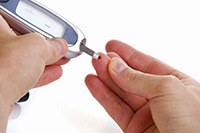Like many other so-called non-communicable diseases (NCDs), diabetes is on the rise worldwide. Here in the United States, 17 million have been diagnosed with the condition, but more strikingly, about one-third of those affected don’t even know about it, according to surveys by the Centers for disease Control and Prevention (CDC).
Not unlike heart disease, diabetes is considered a “silent killer” because it cannot be detected through clearly identifiable symptoms, which contributes to the discrepancy between diagnosed and actual cases.
Diabetes is the seventh leading cause of death among Americans, after heart disease, cancer, stroke, accidents and Alzheimer’s disease. It is the leading cause of blindness, kidney failure, lower extremity amputations, and also increases the risk of heart attack and stroke, according to the CDC.
Diabetes alone accounts for well over $100 billion in direct medical costs and an additional $60 billion in indirect costs such as loss of productivity and disability annually.
Researchers say that the most common form of the disease – type 2 diabetes – is preventable in large parts through lifestyle improvements like weight control, healthy eating and regular exercise.
The easiest way to diagnose diabetes is through a simple blood sugar test. Outside of that, there are a number of symptoms that can indicate whether someone either has or is at risk of developing the disease.
One common sign is frequent urination as well as excessive thirst. The urge to urinate is caused by the kidneys’ struggle to get rid of high amounts of glucose in the blood. The heightened thirst is a response to the need for replenishing the lost fluids. So, for example, having to go to the bathroom repeatedly during the night can be, among other reasons, an indication that the body has difficulties managing high blood sugar.
Other possible symptoms are rapid weight loss (without diet or lifestyle changes), excessive hunger pangs due to sudden drop in blood sugar level, fungal infections (including yeast infections), slow healing of wounds, skin problems like dry skin and skin darkening around the neck and armpit areas, blurry vision, and tingling and numbness in hands and feet, along with pain and swelling because of progressive nerve damaging.
There are several exams available to determine whether a person is diabetic or pre-diabetic, which is a serious health condition in itself. The most common is a blood sugar test administered after a minimum of eight hours fasting. Amounts under 99 milligrams per deciliter (mg/dL) are considered normal. 100 to 125 mg/dL indicates you may be pre-diabetic. Levels above 126 mg/dL means you have the disease.
Untreated diabetes can have dangerous, even life-threatening outcomes. Besides medical intervention, dietary improvements can make a significant difference. While there is no such thing as a specific diet plan for diabetes patients, cutting back or eliminating processed foods that are filled with fat and sugar, and following a regimen that includes plenty of fresh produce is an important step. Weight management (and weight loss, if necessary) as well as fitness training are also essential. Of course, as always, prevention is preferable to any treatment, medical and otherwise.
Timi Gustafson R.D. is a registered dietitian, newspaper columnist, blogger and author of the book “The Healthy Diner – How to Eat Right and Still Have Fun”®, which is available on her blog and at amazon.com. For more articles on nutrition, health and lifestyle, visit her blog, “Food and Health with Timi Gustafson R.D.” (www.timigustafson.com). You can follow Timi on Twitter, on Facebook, Google+ and on Pinterest.


